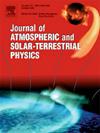广州市云地闪电空间分布与地形的关系
IF 1.9
4区 地球科学
Q3 GEOCHEMISTRY & GEOPHYSICS
Journal of Atmospheric and Solar-Terrestrial Physics
Pub Date : 2025-05-26
DOI:10.1016/j.jastp.2025.106554
引用次数: 0
摘要
根据广东省闪电定位系统(GDLLS),结合ASTER GDEM V2数字高程模型(DEM),对2016-2018年3 - 10月广州地区云对地闪电(CG)数据进行了总结和分析。三年CG闪电的频率和强度逐渐减小。广州的CG闪电以负闪电为主。除广州中心地区外,大部分地区负回冲程率超过80%。广州大部分地区地形为平原,山区主要分布在北部五区。将北部5个地区的CG闪电数据按高程分组,返冲密度曲线随高程升高呈不规则的U形,负平均峰值电流和负冲程百分比曲线整体上升。对比7个地区的地形和CG闪电数据,山地CG闪电活动频率更高,负冲程率更高,地形起伏较小。中部低海拔两侧高海拔的地形区域称为u形区。这种结构可能表明,在这些区域内,大气对流增强,导致雷击密度更高。通过对雷暴穿越路径的分析,发现雷暴通常发生在山地与平地交界处起伏较大的地区。雷暴通常沿着山脉延伸的方向移动。如果雷暴足够强,他们可能会爬过山脉。当雷暴遇到u形区域时,它们倾向于穿越到该区域。本文章由计算机程序翻译,如有差异,请以英文原文为准。
The relationship between cloud-to-ground lightning spatial distribution and topography in Guangzhou
According to the Guangdong lightning location system (GDLLS), the data of cloud-to-ground (CG) lightning in Guangzhou from March to October of 2016–2018 are summarized and analyzed combined with digital elevation model (DEM) from ASTER GDEM V2. Frequency and intensity of three years CG lightning decrease gradually. CG lightning in Guangzhou is mainly negative. Negative return stroke percentage of most areas exceeds 80 % except for center part of Guangzhou. Most areas terrain of Guangzhou is plain, and mountainous areas are mainly distributed in five north districts. By dividing CG lightning data located in five north districts into groups according to elevation, return stroke density curve shows an irregular U shape with elevation rise while negative mean peak current and negative stroke percent curves rise on the whole. Comparing terrain and CG lightning data of 7 selected regions, CG lightning activity of mountainous areas is more frequent with higher negative stroke percent compared to flat ground without much terrain relief. Topographic regions with a central low elevation flanked by higher elevations on both sides are termed U-shaped areas. This structural configuration may suggest that atmospheric convection is enhanced within these regions, resulting in higher lightning strike density. Through thunderstorms traversing paths analysis, it is found thunderstorms usually occur in areas with great relief at the junction of mountains and flat ground. And thunderstorms generally move in the direction of the mountains extending. If the thunderstorms are strong enough, they may climb through the mountains. When thunderstorms encounter a U-shaped area, they tend to traverse to it.
求助全文
通过发布文献求助,成功后即可免费获取论文全文。
去求助
来源期刊

Journal of Atmospheric and Solar-Terrestrial Physics
地学-地球化学与地球物理
CiteScore
4.10
自引率
5.30%
发文量
95
审稿时长
6 months
期刊介绍:
The Journal of Atmospheric and Solar-Terrestrial Physics (JASTP) is an international journal concerned with the inter-disciplinary science of the Earth''s atmospheric and space environment, especially the highly varied and highly variable physical phenomena that occur in this natural laboratory and the processes that couple them.
The journal covers the physical processes operating in the troposphere, stratosphere, mesosphere, thermosphere, ionosphere, magnetosphere, the Sun, interplanetary medium, and heliosphere. Phenomena occurring in other "spheres", solar influences on climate, and supporting laboratory measurements are also considered. The journal deals especially with the coupling between the different regions.
Solar flares, coronal mass ejections, and other energetic events on the Sun create interesting and important perturbations in the near-Earth space environment. The physics of such "space weather" is central to the Journal of Atmospheric and Solar-Terrestrial Physics and the journal welcomes papers that lead in the direction of a predictive understanding of the coupled system. Regarding the upper atmosphere, the subjects of aeronomy, geomagnetism and geoelectricity, auroral phenomena, radio wave propagation, and plasma instabilities, are examples within the broad field of solar-terrestrial physics which emphasise the energy exchange between the solar wind, the magnetospheric and ionospheric plasmas, and the neutral gas. In the lower atmosphere, topics covered range from mesoscale to global scale dynamics, to atmospheric electricity, lightning and its effects, and to anthropogenic changes.
 求助内容:
求助内容: 应助结果提醒方式:
应助结果提醒方式:


